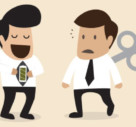The 5 Rules of Cost-Efficient Web Design

Are you planning to have your website designed but have a limited budget? Is your old web design not working as an effective marketing tool? Are you launching a new website and want to get the best bang for your buck?
If you answer Yes to any these questions, there are several aspects of web design you should consider if you want to keep your website development cost-efficient. You need to understand these basic rules in order to produce the best possible outcome.
1. Use the universal standards of web design
There are certain standards that you should follow in website design that will help make your website user friendly. Consistent ways of doing things online have developed over the years that people have learnt to understand and interact with. For example the use of blue fonts for links is popular. These blue fonts are also usually underlined. If you want to break this basic rule then you should have a good reason behind it. The last thing you want to do is confuse your visitors when interacting with your website so if blue links look okay in your website design, I suggest you stick with it. If you do break or bend any of the universal standards, make sure you consider usability and make it obvious how people should interact with your website.
2. Use common positioning of web elements.
Never chop and change the positioning of elements in your website from page to page. It’s not a time to get tricky. It’s a website, not a ‘Where’s Wally’ experience. There has to be a designated place for every item so it is easy for the user to navigate. It is imperative, your menu should stay in the same place always. Whether it’s at the top or side, it doesn’t really matter, just so long as it is easy to find and use.
3. Use contrast in web design.
Make sure people are able to distinguish your content in your website. Keep in mind your site visitors won’t always be using a desktop PC when browsing through your site. They could be using a netbook, an iPod, a mobile phone, an iPad or a laptop. They may also be using an old, poor quality PC monitor so, you should always make sure you provide a contrasting design that will make your website clear and easy to read even in the worst of situations.
4. Use Left aligned text in web design.
From a legibility standpoint, it’s much easier to read left aligned text than centred or right aligned text particularly on small monitors where scrolling is involved. Centred and right aligned text can be interesting but should only be used in small doses. I’d suggest you stay clear of it unless you are a professional graphic designer with experience in typesetting.
5. Use interactivity in web design.
The Internet has provided ever increasing capabilities to web designers. Creating interactive websites is now quick, easier and more cost effective than years gone by. There is now a range of existing ‘plug-n-play’ solutions that can be integrated with your website. For example, you can easily introduce social media features, comments and shopping carts to almost any website these days. It’s just a matter of researching to see what existing systems are out there that you can adapt for your desired result. The opportunities are almost endless.





